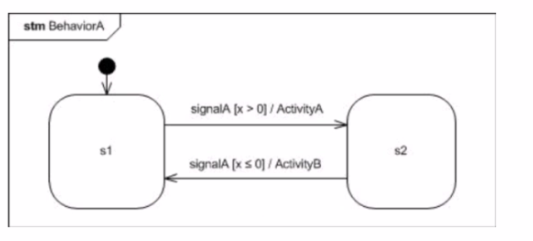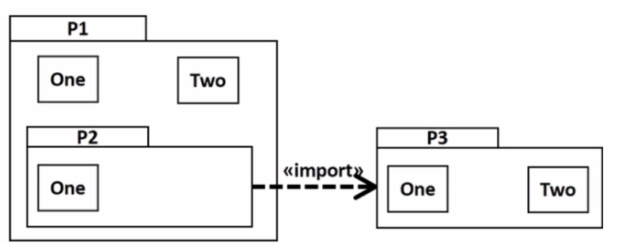OMG-OCUP2-FOUND100 OMG Certified UML Professional 2 (OCUP 2) - Foundation Level Exam Practice Test
Choose the correct answer:
The BchaviorA state machine shown below is at rest in state s1 and the value of x Is 0.

If a signalA event occurs, what is the state machine's subsequent behavior?
Answer : C
The image showcases a state machine named 'BehaviorA'. It consists of two states: s1 and s2. There's also a transition labeled 'signalA' connecting these states. However, a guard condition, '[x > 0]' is placed on the transition. This indicates that the signalA event will only trigger the transition if the expression x > 0 evaluates to true.
In the scenario you described, the state machine is currently in state s1, and the value of x is 0. Since the guard condition '[x > 0]' is not satisfied (because x is 0), the signalA event will not trigger a transition to state s2.
Here's a breakdown of why other options are incorrect:
Option A (The state machine will transition to state s2 and execute ActivityA during the transition) is not valid because the guard condition prevents the transition.
Option B (The state machine will execute ActivityA and remain in state s1) is incorrect as ActivityA is only associated with the transition, which isn't happening in this case.
Option D (The state machine will remain in state s1, and processing of the signalA event occurrence will be deferred until either the value of x changes or the state machine changes state) is not entirely accurate. While the state machine remains in s1, the processing of the signalA event is consumed immediately, not deferred.
Therefore, considering the state machine's visual representation and the guard condition, option C best describes the state machine's behavior. The signalA event is acknowledged but has no effect because the transition requirements aren't met.
Choose the correct answer:
Which statement is correct about Activity precondition and postcondition constraints?
Answer : B
Activitypreconditionandpostconditionconstraints are essential for specifying conditions that apply to an activity. Let's break down the concepts:
Precondition:
Apreconditionrepresents a condition that must betrue beforethe activity can start or be invoked.
It ensures that the necessary prerequisites are met before executing the activity.
For example, a precondition for an activity related to booking a flight might be that the user has already logged in to the system.
In UML, preconditions are typically expressed using natural language or constraints.
These constraints can be associated with the entire activity or specific actions within it.
Postcondition:
Apostconditionspecifies a condition that must betrue afterthe activity completes.
It captures the expected state or outcome resulting from the activity's execution.
For instance, a postcondition for the flight booking activity might be that the reservation has been successfully confirmed.
Similar to preconditions, postconditions can apply to the entire activity or individual actions within it.
Application Scope:
Bis the correct answer because preconditions and postconditions applyonly to specific invocationsof the activity.
They do not universally apply to all invocations of the same activity.
Different invocations of the same activity may have distinct preconditions and postconditions based on context or input parameters.
Constraining Actions vs. Flow of Objects:
OptionCis incorrect because preconditions and postconditions are not primarily used to constrain specific actions within the activity.
OptionDis also incorrect because they are not limited to constraining only the flow of objects within the activity.
Instead, preconditions and postconditions focus on the overall conditions for invoking and completing the activity.
Sparx Systems.''Use Case Diagram - UML 2 Tutorial.''2
Stack Overflow.''UML Use-case diagram postcondition implementation (with diagram).''3
Choose the correct answer:
Which statement is true about the following diagram?

Answer : C
The execution starts from activity A (as there's no incoming transition).
From A, there's only one outgoing transition leading to activity E.
Following the transition from E, the flow reaches activity C.
There are no further outgoing transitions from C, signifying the end of the valid trace.
Explanation of Why Other Options are Incorrect:
A . E waits for an Event:The diagram doesn't show an explicit wait event associated with activity E. While an event might trigger the initial start of the activity A, the provided trace (A, E, C) focuses on the control flow between the activities themselves.
B . E is always executed faster than B:There's no basis to establish a timing relationship between E and B based solely on the structure of the diagram. The order of execution is A, E, C, but their relative speeds cannot be determined from this information.
D . C waits for tokens on both incoming edges:Activity C has two incoming transitions, but the concept of waiting for tokens on both edges simultaneously doesn't apply here. Since the flow reaches C from activity E, only the transition from E provides the token needed to enable C's execution.
Trace vs. Path
It's important to distinguish between trace and path in an activity diagram:
Trace:A specific sequence of activity executions along a feasible path.
Path:A possible route through the activity diagram, which may or may not be a valid trace depending on the presence of decisions or loops.
In this case, the answer focuses on the valid trace A, E, C, which represents a confirmed sequence of activity executions based on the transitions in the diagram.
Reference
Choose the correct answer:

Consider the following two diagrams:
Which description of these diagrams is true?
Answer : A
Start Node:Represented by a black circle, indicating the starting point of the activity.
Action a:Represented by a rounded rectangle, signifying an action or step within the activity.
Action READY:Another rounded rectangle representing an action.
End Node:A circle with a black dot inside, marking the end point of the activity.
Based on the common elements in both Act1 and Act2:
The activity starts at the designated start node.
It proceeds to action 'a'.
Then it moves to action 'READY'.
Finally, it reaches the end node, signifying completion.
There are no additional branches or loops that would allow for re-starting the activity or re-executing action 'a' multiple times.
Analysis of Other Options:
B . Initial and final nodes are optional...While it's true that initial and final nodes can be implicit in some cases, well-formed activity diagrams typically include them for clarity. Here, both diagrams have them explicitly.
C . In diagram Act1. action a can get executed once...There's no basis to claim a difference in the number of executions of action 'a' between the two diagrams.
D . Diagram Act2 is incomplete...Both diagrams seem complete as they have proper start and end nodes, and the flow goes from start to finish without any ambiguity.
Therefore, considering the structure and execution flow, both Act1 and Act2 will end after the 'READY' action, and no further signals will be accepted, making answer A the most accurate description.
Choose the correct answer:
Which statement is correct regarding object (lows and control flows?
Answer : B
Represent the movement of data or objects between activities.
Can support multicast, meaning sending a single token to multiple recipients.
Can support transformation, where input tokens are altered or transformed into different output tokens.
Control Flows
Represent the sequence of execution between activities.
Generally carry control tokens to indicate when the next activity can begin.
Explanation for why Answer B is Correct
Multicast and Transformation:Object flows are specifically designed to handle more complex scenarios with multiple inputs, outputs, and the ability to transform data. Control Flows are focused on the order of execution and don't directly support these capabilities.
Analysis of Other Options:
A . Both object flows and control flows can pass...: While both can carry tokens, the specializations of multicast and transformation are unique to object flows.
C . Only control flows provide additional support...: This is incorrect. As mentioned above, these features are associated with object flows, not control flows.
D . Only object flows may reorder...: This is potentially true, but less central to the main difference between object flows and control flows, which is the ability of object flows to support multicast and transformation.
Reference
Choose the correct answer:
Which statement is true about the following diagram?

Answer : D
The diagram likely represents a UML activity diagram, which is used to model the workflow of a system. The correct answer is D because it reflects the behavior of decision nodes and concurrent flows in UML activity diagrams.
In UML, when an activity reaches a decision node (depicted as a diamond), it chooses one among several alternative flows. In this case, after the completion of action A, the flow must decide between B or D, but not both, which is a fundamental aspect of decision nodes in UML. This is supported by the UML 2.5 specification, which states that a decision node routes tokens to one of the available outgoing edges based on the conditions evaluated at runtime, ensuring that only one path is taken.
Furthermore, the UML specification explains that the notation for decision nodes and the semantics of token flows are such that they support the modeling of conditional and concurrent behaviors within an activity. This is essential for accurately capturing the logic of complex systems and their operations.
For a more in-depth understanding, you can refer to the UML 2.5.1 specification provided by the Object Management Group (OMG), which details the notation and semantics of activity diagrams, including decision nodes and flows. Additionally, studying the official OMG UML 2 Certification Guide can provide further clarification on these concepts.
Choose the correct answer:
Consider the following diagram:

Which element(s) from P3 are visible inside P2 without using a qualified name?
Answer : B
In UML, the <<import>> relationship indicates that the namespace of the target element (in this case, P3) is added to the namespace of the source (in this case, P2). However, it's important to distinguish between different types of imports. There are two types of import relationships:
Public Import: If P2 were to import P3 publicly (using <<import>>), then all public members of P3 would become accessible to P2 as if they were part of P2.
Private Import: If P2 were to import P3 privately (using <
Given the diagram, it seems that P2 is importing P3 (the nature of the import, public or private, is not explicitly mentioned). Assuming it is a public import and considering that P2 itself is within P1, which is the higher-level package, then P1 has visibility over its own contents as well as any elements imported into P2.
Element One in P3 has the same name as One in P1, and typically in UML, when an element is imported into a namespace where an element with the same name exists, the imported element is not accessible without a qualified name to avoid ambiguity. However, since P2 is within P1, it could be argued that One in P3, when imported, would effectively 'merge' with One in P1, thereby making One visible inside P2 without a qualified name due to its presence in the higher-level package P1.
Therefore, the correct answer is:
B . One